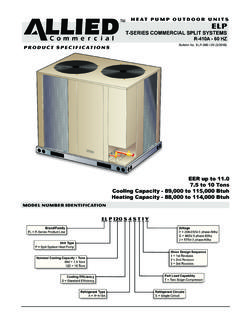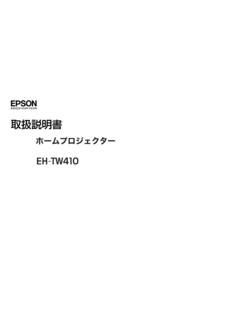Transcription of IMPEDANCE SPECTROSCOPY: A GENERAL …
1 CHAPTER 12 IMPEDANCE spectroscopy : A GENERAL introduction AND APPLICATION TO DYE-SENSITIZED SOLAR CELLSJuan Bisquert and Francisco INTRODUCTIONI mpedance spectroscopy (IS) has become a major tool for investigating the properties and quality of dye-sensitized solar cell (DSC) devices. This chapter provides an intro-duction of IS interpretation methods focusing on the analysis of DSC IMPEDANCE data. It also presents a scope of the main results obtained so far. IS gives access to funda-mental mechanisms of operation of solar cells, for which reason we discuss our views of basic photovoltaic principles required to realize the interpretation of the experi-mental results.
2 The chapter summarizes some 10 years of experience of the authors with regard to modeling, measurement and interpretation of IS applied in good way to start this subject is a brief recollection of how it evolved over the fi rst years. The original standard confi guration of a DSC [ ] that emerged in the early 1990s is formed by a large internal area constituted of a nanostructured TiO2 semiconductor, connected to a transparent conducting oxide (TCO) and coated with photoactive dye molecules. It is furthermore in contact with a redox II 3 / electrolyte that is in turn connected to a Pt-catalyzed counterelectrode (CE).
3 The DSC was ini-tially developed to be a photoelectrochemical solar cell. Electrochemical IMPEDANCE spectroscopy (EIS) is a traditional method, central to electrochemical science and technology. Electrochemistry usually investigates interfacial charge transfer between a solid conductor (the working electrode, WE) and an electrolyte. This is done with a voltage applied between the WE and CE, with the assistance of a reference electrode (RE), rendering it possible to identify the voltage drop at the interface between the WE and the electrolyte.
4 In addition, the electrolyte often contains a salt that provides a large conductivity in the liquid phase and removes limitations by drift transport in an electrical fi eld. Electrochemistry is thus mostly concerned with interfacial charge transfer events, possibly governed by diffusion of reactants or products. It is with EIS 2 Dye-sensitized solar cellspossible to readily separate the interfacial capacitance and charge-transfer resistance, as well as to identify diffusion components in the electrolyte.
5 A good introduction to such applications is given by Gabrielli [ ].In solid state solar cell science and technology, the most commonly applied frequency technique is Admittance spectroscopy (AS). By tradition, AS denominates a special method that operates at reverse voltage and evaluates the energy levels of majority carrier traps (in GENERAL , all those that cross the Fermi level) as well as trap densities of states [ ]. In work on DSCs and other solar cells, we may be interested to probe a wide variety of conditions. Consequently, we generally use the denomina-tion IMPEDANCE spectroscopy (IS) when referring to the technique applied in this context (rather than EIS or AS).
6 Before the advent of DSC, IS had been largely applied in photoelectrochem-istry [ , ]. This is a fi eld widely explored since the 1970s, using compact monocrystalline or polycrystalline semiconductor electrodes for sunlight energy con-version [ ]. In these systems, IS provides information on the electronic car-rier concentration at the surface, via Mott-Schottky plots ( , the reciprocal square capacitance versus the bias voltage) as well as on the rates of interfacial charge trans-fer [ ]. Several important concepts, later to be applied in DSC, where estab-lished at that time, such as the bandedge shift by charging of the Helmholtz layer and the crucial role of surface states in electron or hole transfer to acceptors in solution [ , , ].
7 Nonetheless, it was clearly recognized that applying IS in these systems is far from trivial, for example due to the presence of frequency disper-sion that complicates the determination of parameters [ ]It was natural to apply such well-established electrochemical methods to DSC and several groups have done so [ ]. However, in the early studies, it was necessary to clarify a conceptual framework of interpretation which took several years. On the one hand, the early diffusion-recombination model [ ] was generally adopted for steady-state techniques and produced very good results when extended to light-modulated frequency techniques [ ].
8 In this approach, the only role of the applied voltage is to establish the concentration of electrons at the edge of the TiO2 in contact with TCO [ , ]. On the other hand, classical photoelectrochemical methods heavily rest on the notion of charge collection at the surface space-charge layer, while diffusion is viewed as an auxiliary component, at best [ ]. Thus, in photoelectrochemistry of compact semiconductor electrodes, the main method to describe the system behavior is an understanding of the electric potential distribution between the bulk semiconductor and the semiconductor/electrolyte interface [ ].
9 Owing to these confl icting approaches, in the DSC area there were many discus-sions concerning the distribution of the applied voltage as internal potential drops , the origin of photovoltage, screening, and the role of electron-hole separation at the space-charge region [ ]. This is understandable since the DSC is a porous, heterogeneous system, and in models of systems with a complex morphology, it is generally diffi cult to match diffusion control with a precise statement regarding the electrical potential distribution. The key element for progress is to adopt a macro-homogeneous approach and focus in the spatial distribution of the Fermi level.
10 This method emerged in the DSC area [ , ] and eventually led to gener-alized photovoltaic principles based on the splitting of Fermi levels and the crucial IMPEDANCE spectroscopy 3role of selective contacts [ ]. Another central concept that appeared in the DSC area was a conduction band capacitance [ , , ], later to be generally defi ned as a chemical capacitance [ ].





